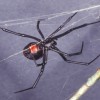Abstract
The Southern black widow spider, Latrodectus mactans (Fabricius), is a venomous spider found throughout the southeastern United States. Widow spiders received their name from the belief that they would kill and consume their mate following copulation. However, the practice was mainly observed in laboratory settings under crowded conditions. It is believed that sexual cannibalism within the widow species in natural settings is more associated with the male’s physical inability to escape rather than the female’s interest in consuming him. This 6-page fact sheet was written by Amanda Eiden and Phil E. Kaufman and published by the UF Department of Entomology and Nematology, May 2013.
References
Baerg WJ. 1923. The effects of the bite of Latrodectus mactans Fabr. The Journal of Parasitology 9: 161-169.
https://doi.org/10.2307/3271093
Baxter Deevey G. 1949. The developmental history of Latrodectus mactans (Fabr.) at different rates of feeding. American Midland Naturalist 42: 189-219. https://doi.org/10.2307/2421795
Bogen E, Loomis RN. 1936. Poisoning poisonous spiders, an experimental investigation in the control of the black widow spider (Latrodectus mactans). California and Western Medicine 45: 31-38.
Breene RG, Sweet MH. 1985. Evidence of insemination of multiple females by the male black widow spider, Latrodectus mactans (Araneae, Theridiidae). Journal of Arachnology 13: 331-335.
Bronstein AC, Spyker DA, Cantilena LR, Green JL, Rumack BH, Dart C. 2011. 2010 annual report of the American Association of Poison Control Centers' national poison data system (NPDS): 28th annual report. Clinical Toxicology 49: 910-941. https://doi.org/10.3109/15563650.2011.635149
Clark RF, Wethern-Kestner S, Vance MV, Gerkin R. 1992. Clinical presentation and treatment of black widow spider envenomation: A review of 1963 cases. Annals of Emergency Medicine. 21: 782-787. https://doi.org/10.1016/S0196-0644(05)81021-2
Clark RF. 2001. The safety and efficacy of antivenin Latrodectus mactans. Clinical Toxicology 39: 125-127.
https://doi.org/10.1081/CLT-100103827
D'Amour FE, Becker FE, van Riper W. 1936. The black widow spider. The Quarterly Review of Biology 11: 123-160.
https://doi.org/10.1086/394503
Draney ML. (2001). Checklist of Theridiidae (Araneae) of America north of Mexico. Department of Natural and Applied Sciences.University of Wisconsin-Green Bay.
Edwards GB. (2002). Venomous Spiders in Florida. Pest Alert. Florida Department of Agriculture and Consumer Services, Division of Plant Industry. (12 March 2013).
Garb JE, González A, Gillespie RG. 2004. The black widow spider genus Latrodectus (Araneae: Theridiidae): phylogeny, biogeography, and invasion history. Molecular Phylogenetics and Evolution 31: 1127-1142. https://doi.org/10.1016/j.ympev.2003.10.012
Handel CC, Izquierdo LA, Curet LB. 1994. Black widow spider (Latrodectus mactans) bite during pregnancy. Western Journal of Medicine 160: 261-262.
Kaston BJ. 1938. Notes on a new variety of black widow spider from southern Florida. Florida Entomologist 21: 60-61. https://doi.org/10.2307/3492683
Kaston BJ. 1954. Is the black widow spider invading New England? Science 119: 192-193. https://doi.org/10.1126/science.119.3084.192
Kaston BJ. 1972. Comparative biology of American black widow spiders. Transactions of the San Diego Society of Natural History 16: 33-82.
MacKay WP. 1982. The effects of predation of western widow spiders (Araneae: Theridiidae) on harvester ants (Hymenoptera: Formicidae). Oecologia 53: 406-411. https://doi.org/10.1007/BF00389022
McCrone JD. 1964. Comparative lethality of several Latrodectus venoms. Toxicon 2: 201-203. https://doi.org/10.1016/0041-0101(64)90023-6
Mote DC, Gray K. 1935. The black widow spider (Latrodectus mactans Fabr.). Agricultural Experiment Station Oregon State Agricultural College. Station Circular 112: 11pp. (30 May 2013).
Nyffeler M, Dean DA, Sterling WL. 1988. The southern black widow spider, Latrodectus mactans (Araneae, Theridiidae), as a predator of the red imported fire ant, Solenopsis invita (Hymenoptera, Formicidae), in Texas cotton fields. Journal of Applied Entomology 106: 52-57. https://doi.org/10.1111/j.1439-0418.1988.tb00563.x
Offerman SP, Patrick Daubert G, Clark RF. 2011. The treatment of black widow spider envenomation with antivenin Latrodectus mactans: a case series. The Permanente Journal 15: 76-81. https://doi.org/10.7812/TPP/10-136
Orlova EV, Atiqur Rahman M, Gowen B, Volynski KE, Ashton AC, Manser C, van Heel M, Ushkaryov YA. 2000. Structure of α-latrotoxin oligomers reveals that divalent cation-dependent tetramers form membrane pores. Nature Structural Biology 7: 48-52. https://doi.org/10.1038/71247
Rempel JG. 1957. The embryology of the black widow spider, Latrodectus mactans (Fabr.). Canadian Journal of Zoology 35: 35-74. https://doi.org/10.1139/z57-004
Ross K, Smith RL. 1979. Aspects of the courtship behavior of the black widow spider, Latrodectus hesperus (Araneae: Theridiidae), with evidence for the existence of a contact sex pheromone. Journal of Arachnology 7: 69-77.
Sherman RP, Groll JM, Gonzalez DI, Aerts MA. 2000. Black widow spider (Latrodectus mactans) envenomation in a term pregnancy. Current Surgery 57: 346-348. https://doi.org/10.1016/S0149-7944(00)00276-2
Timms PK, Gibbons RB. 1986. Latrodectism-effects of the black widow spider bite. Western Journal of Medicine 144: 315-317.
Vetter RS. (2013) The brown widow spider, Latrodectus geometricus. The University of California, Riverside. Center for Invasive Species Research. (24 May 2013).
Vetter RS. The prevalence of brown widow and black widow spiders (Araneae: Theridiidae) in urban Southern California. Journal of Medical Entomology 49: 947-951. https://doi.org/10.1603/ME11285
Wolfe MD, Myers O, Caravati EM, Rayburn WF, Seifert SA. 2011. Black widow spider envenomation in pregnancy. The Journal of Maternal-Fetal and Neonatal Medicine 24: 122-126. https://doi.org/10.3109/14767058.2010.481317
Zevenbergen JM, Schneider NK, Blackledge TA. 2008. Fine dining or fortress? Functional shifts in spider web architecture by the western black widow Latrodectus hesperus. Animal Behaviour 76: 823-829. https://doi.org/10.1016/j.anbehav.2008.05.008
This work is licensed under a Creative Commons Attribution-NonCommercial-NoDerivs 4.0 International (CC BY-NC-ND 4.0) license.

